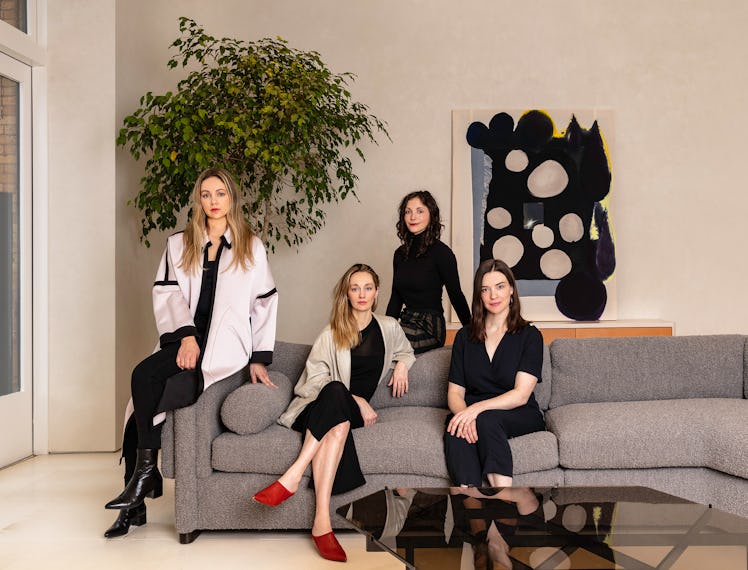Designing Women Exhibition Explores the Intersection of Motherhood and Creativity
The show at the New York City design studio Egg Collective highlights women creators whose family lives play a pivotal role in their work.

Many things were put on hold during the pandemic, but some of them are still as relevant as ever. Designing Women III: MOTHER, is finally on view at Egg Collective’s space, in New York City’s Tribeca neighborhood, through May 29th. The furniture, lighting, and accessory design firm’s partners—Stephanie Beamer, Crystal Ellis, and Hillary Petrie—co-curated the show with Tealia Ellis Ritter, an artist (and Crystal Ellis’s sister). The third in a series of exhibitions that Egg Collective has curated since 2017 focusing women in design and art, this one includes twenty-eight contemporary designers and artists and modern art and design legends, with a focus on balancing work and motherhood.
In her curatorial statement for the exhibition, Ellis Ritter cites as inspiration the photographer Imogen Cunningham’s portrait of the artist Ruth Asawa, hard at work and surrounded by her four children. Ellis Ritter points to the “motherhood penalty,” which describes the unconscious bias against women with children that leads to lower wages and lack of advancement. (Not to mention, these days, navigating work, school, and childcare during a pandemic.) The exhibition seeks to celebrate women who have overcome these obstacles.
Work installed in one of the rooms of Egg Collective’s Tribeca space. From left: Tealia Ellis Ritter’s “Protective Gestures”, 2020; Elizabeth Atterbury’s work; Gae Aulent’s “‘Jumbo’ Table in Marble”, 1970s; Konekt’s “Armor Floor Lamp”. Photo by Nicole Franzen.
Among the pieces by contemporary designers and artists, Two Wangs and Moms, a pair of subtle wall pieces made with mortar on plywood by the Portland, Maine-based artist Elizabeth Atterbury, refer to her Chinese-American mother, as well as her grandparents and stepmother, in “an open-ended meditation” about motherhood and family. Atterbury has two young children; a third mortar piece is based on the curved form of a breast-pump tab. Ellis Ritter’s Protective Gestures is a grid of twelve gelatin prints depicting her son, with photograms of her own hands superimposed on him. Brooklyn-based Hannah Whitaker’s prints, Salute and Kick, look like graphic design but are photographs made with multiple exposures; they offer commentary on automation and women’s bodies. In addition to the arms and feet in the prints, Whitaker slyly inserts a profile view of a breast into Kick, referring to “the sweetness of early motherhood.” Carmen Winant’s Body Index is a collage of found images of women’s bodies.
Luna Paiva, who lives in Barcelona and is about to have her third child, created the spiky sculpture Yucca out of bronze. “I associate plants with life,” she says, adding that she’s particularly drawn to species that are “almost invisible, and that are often left aside.” The New York-based artist Carolyn Salas, who makes a lot of abstract sculpture, calls TBT, the tufted tapestry that depicts a reclining female nude, “atypical,” but hopes it conveys a sense of beauty and strength. Jean Pelle, who runs the Red Hook studio, PELLE, with her husband, Oliver, credits their tag-team approach to caring for their two daughters and a supportive school program with making work possible during the past year. Her delicate piece Lure Radiata is composed of leaves of cast and sanded cotton paper that she makes in the studio and then paints individually to create a colored gradient. For Katrina Vonnegut, the form of the Bow chair—designed with Brian Kraft, her work and life partner—and made of laminated solid oak that is routed, glued, and then upholstered, is an “unfurling, peeling gesture.” Rachel Cope, who founded Calico Wallpaper with her husband, Nicholas Cope, collaborated with their six-year-old daughter, Willow, making oil-stick drawings on the linen wall covering in one room.
Also on display: a selection of work by art and design legends, including a screen print by the artist, writer, and activist Faith Ringgold that depicts Selma Burke, whose portrait of Franklin Delano Roosevelt on the U.S. dime is famous, although she received no credit for it. A pairing of pieces by two designers in their 90s features a 1968 stainless steel table by Maria Pergay, who became a superstar for her furniture designs (including a cabinet with a giant safety-pin handle that is in the show), developed while she was raising four children; and a 1960 hanging light by Lucia DeRespinis, a lesser-known but no less accomplished designer, who still teaches at Pratt Institute. The light was one of many products DeRespinis designed (without credit) while working for George Nelson; in 1975, she created the now-iconic Dunkin’ Donuts logo, using her daughter’s favorite colors.
Twentieth century Italian design is represented by Gae Aulenti and Lella Vignelli, while rustic furniture by Charlotte Perriand stands before a quilt (one of two in the show) by Loretta Pettway Bennett, a member of the renowned Gee’s Bend Quilters. A modular play structure is the work of the German designer Renate Müller, who has been making therapeutic toys for children since the 1960s. Eva Zeisel’s small, colorful jug from 1929 prefigures her prodigious ceramics and tableware output. A photograph of plants by Imogen Cunningham alludes to the fact that while raising three children, she was confined to photographing her garden. The French artist Line Vautrin, who has three bronze boxes in the show, was a postwar pioneer in allowing people in her studio to work part-time from home.
Fittingly, the exhibition’s website offers two ways to contribute to Every Mother Counts, an organization committed to making childbirth safe for all women: either by clicking the “donate” button, or by buying a copy of the exhibition’s poster, which was designed by the New York artist Shawna X.